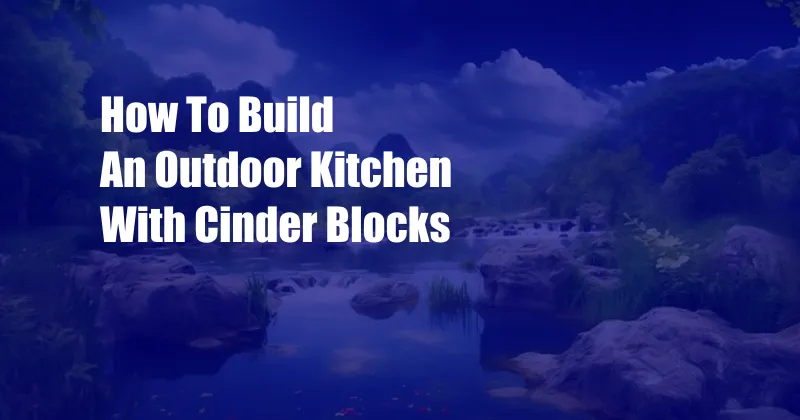
How to Build an Outdoor Kitchen with Cinder Blocks: A Comprehensive Guide
Introduction
As an avid outdoor enthusiast, I’ve always dreamed of having an outdoor kitchen where I could entertain friends and family while enjoying the beauty of nature. After countless hours of research, I decided to embark on the adventure of building my own outdoor kitchen using cinder blocks.
Building Materials: Cinder Blocks
Cinder blocks, also known as concrete blocks, are a popular choice for outdoor construction due to their durability, affordability, and ease of use. These blocks are made from a mixture of concrete, sand, and cinders, making them extremely sturdy and resistant to fire and moisture.
Planning the Kitchen
Before you begin construction, it’s essential to create a detailed plan for your outdoor kitchen. Consider the location, size, and layout of the kitchen to ensure that it meets your needs and complements the existing outdoor space. Determine the appliances and features you want to include, such as a grill, refrigerator, and sink.
Building the Kitchen
1. Laying the Foundation
The first step is to lay the foundation for your outdoor kitchen. Dig a trench and pour a concrete slab over a compacted gravel base. Ensure that the slab is level and slopes slightly away from the kitchen area for proper drainage.
2. Building the Walls
Once the foundation has cured, you can begin building the walls using cinder blocks. Mortar is required to hold the blocks together. Apply mortar to the base of each block and carefully stack them on top of each other, ensuring that the walls are plumb and level.
3. Creating the Countertop
For the countertop, you can use poured concrete or tiles. If using concrete, pour it into a mold placed on top of the walls. Smooth the concrete and let it cure. If using tiles, apply adhesive to the surface of the walls and install the tiles, ensuring that they are level and aligned.
4. Installing Appliances
Once the countertop is complete, it’s time to install the appliances. Cut openings in the countertop or walls for the grill, refrigerator, and sink. Carefully follow the manufacturer’s instructions for proper installation and connection to gas or water lines.
5. Adding Finishing Touches
To complete the kitchen, add finishing touches such as cabinets, shelves, and lighting. Cabinets provide storage space for utensils and supplies, while shelves can hold spices and other essentials. Lighting ensures that the kitchen is well-lit for evening gatherings.
Trends and Developments
Outdoor kitchens have become increasingly popular, leading to the emergence of new trends and developments. One trend is the use of modular components, which allows for easy customization and reconfiguration of the kitchen. Another trend is the incorporation of smart appliances, such as grills that can be controlled remotely via smartphones.
Expert Advice
- Use quality materials: Opt for high-quality cinder blocks, mortar, and appliances to ensure durability and longevity.
- Waterproof the kitchen: Seal the countertop and walls with a waterproof sealant to protect against moisture damage.
- Maintain the kitchen: Regularly clean the kitchen and appliances to keep them in good condition and prevent rust or corrosion.
FAQs
Q: How much does it cost to build an outdoor kitchen with cinder blocks?
A: The cost varies depending on the size, complexity, and materials used. However, a basic kitchen can be constructed for around $2,000-$5,000.
Q: Can I build the kitchen on my own?
A: With the right tools and planning, it is possible to build an outdoor kitchen on your own. However, it’s recommended to consult with a professional if you have limited experience in masonry or electrical work.
Conclusion
Building an outdoor kitchen with cinder blocks is a rewarding and cost-effective project that can enhance your outdoor living space. By following the steps outlined above, using quality materials, and incorporating the latest trends, you can create a beautiful and functional kitchen that will be enjoyed for years to come.
Are you ready to embark on your own outdoor kitchen build?